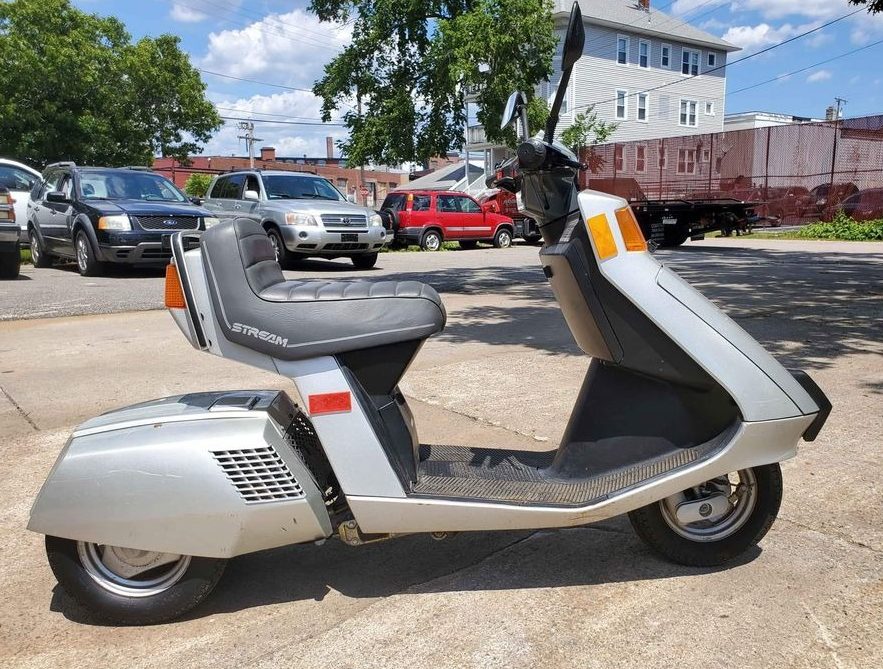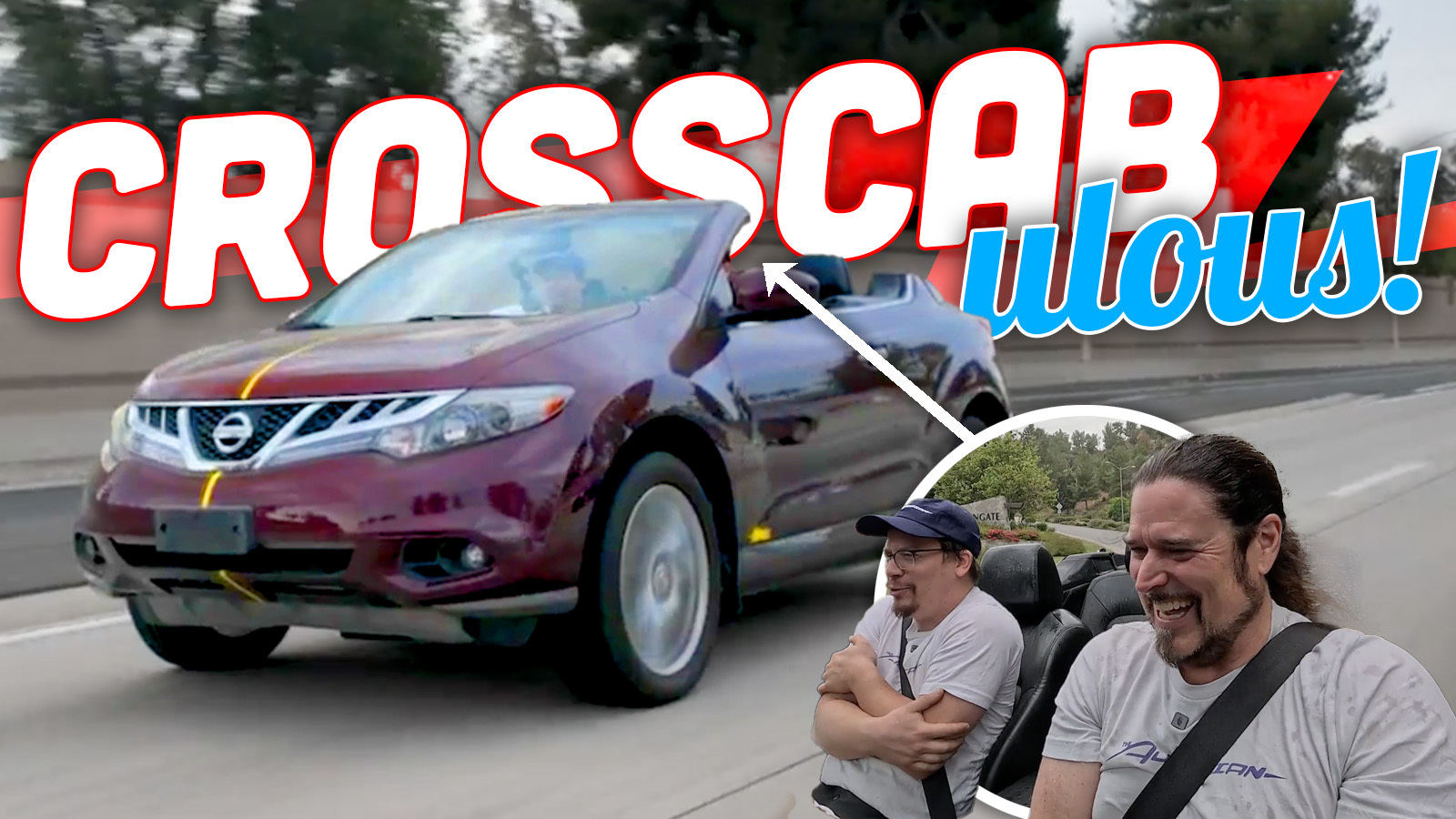Scooters are a fantastic way to get around. They’re easier to operate than a car and scooters with a step-through design could be used by anyone from guys in business suits to women in dresses. But, a scooter doesn’t handle like a motorcycle and isn’t as comfortable as a car. Back in the 1980s, Honda engineers sought to combine the best attributes of cars and bikes in a new type of scooter, and the result was the Honda Stream: a weird three-wheeled scooter that allowed the rider/driver to lean into turns with the front wheel while the two rear wheels stayed planted on the pavement, lean-free. It wasn’t exactly a car minus a wheel, but it remains one of the coolest scooters you can buy today.
Honda’s powersports division isn’t afraid to try something different. It has a long history of turning outlandish ideas into new niches, seeming to do so at times just because it can. This is a brand that made an automatic motorcycle that looked like one of Batman’s rides and has offered bikes optimized for people who don’t ride.
Making a scooter that’s as comfortable as a car is just another one of Team Red’s weird ideas. Yet, it seems that Honda somehow found a niche of people who want just that.
British Roots

Honda’s leaning trike traces back to a patented design by George Leslie Wallis. In the 1920s, Wallis ran Wallis Motors Ltd., which produced his motorcycle inventions. Reportedly, Wallis revved up his career in motorcycles when, at 20 years old, he became the manager of Harley-Davidson’s British division’s racing team.
As Cycle World writes, Wallis is best known for the innovations he brought to the motorcycling world. In 1925, Wallis decided to build a motorcycle with car-like steering and constructed a street motorcycle with a tubular chassis and hub-center steering. Wallis wasn’t the first to build a motorcycle with this still-novel technology (the Ner-a-Car came sooner), but he was an early innovator. Reportedly, this motorcycle had racing potential and Wallis even entered it into a few races in 1926, but he couldn’t secure the funding to put the motorcycle into production.

After the failure of the hub-steering motorcycle, Wallis moved to British speedway racing and built motorcycles inspired by the American Harley Peashooter. His version had a shorter wheelbase, better for Britain’s tighter racetracks. His dirt racers found great success, and racked up countless race wins along with sales of over 1,000 units. As Cycle World writes, Wallis then disappeared from motorcycling, when production of the dirt racers ended in 1932. Wallis went on to spend over 30 years as a businessman, managing a garage and a restaurant, and using his design talent to develop fertilizer spreaders and radar navigation equipment.
As Cycle World continues, Wallis found himself on a trip to Portugal in 1965. During an overnight stop in France, he witnessed scooters and mopeds whizzing by his hotel balcony. Watching those scooters gave Wallis an idea, and he halted the rest of his three-week vacation to get the idea down on paper.

Wallis’ idea was to build a scooter that was safer than anything he saw in France. Reportedly, when Wallis went home, he found patents for earlier designs, built some prototypes, and concluded that none of them worked. His design would first differ by adding a third wheel, located in the rear where the engine is. But that wasn’t enough, and Wallis decided to add a pivot point just ahead of the engine where the main frame would meet the subframe. This allowed the front portion of the scooter to lean over 40 degrees while the two rear wheels remained planted at all times.
The scooter, which was designed to have a moped variant and faster versions, had stabilizer springs to cushion the banking motions and to help the scooter right itself when the rider is traveling straight. Power came from a Mobilette 49cc two-stroke and it was also designed so that if you locked the brakes, the scooter would skid to a halt upright. There was also a foot pedal that, when pressed, locked the scooter frame from leaning. At the time, motorcycle magazines hailed the scooter as a vehicle you could not fall off of.

In 1965, Wallis’ company G.L. Wallis and Son, Ltd. sought a patent for the invention and Wallis was quick to license the design. BSA was the first to take on the design and created the Ariel 3 leaning trike scooter in 1970 (above).
This was a moped with pedals and a 50cc Anker two-stroke engine. It had three interchangeable wheels and only one of the rear wheels was driven. It’s estimated that BSA spent £2 million on the development of the Ariel 3 and expected sales of 25,000 units. However, just 7,000 were built. The Ariel 3 is sometimes said to be one of the bikes that led to the demise of BSA.

In the 1970s, another company would license the Wallis leaning trike design. In 1974, Daihatsu launched the Hallo three-wheel scooter (above). This scooter followed a very similar design philosophy as the Ariel, but did away with the pedals. Instead, it was powered solely by motor power. The original Hallo had a 50cc two-stroke engine, but Daihatsu also experimented with an electric version that fed a motor from two 12-volt batteries, offering a range of 18 miles and a top speed of 18 mph. It’s unclear for how long Daihatsu built the Hallo, but it was another short-lived project.
Honda Goes Long

In the early 1980s, Honda was the next company to take on a license from the patent, and it would be the company to do the most with the Wallis leaning trike design.
According to Honda, it began the development of the Stream to create a new kind of scooter. Back then, Honda realized that while scooters and cars had separate markets, both were trending toward convenient use. So, why not combine them together? Honda went as far as to call it a new category of vehicle called a “sleater,” or “a three-wheeled vehicle with a swing mechanism that combines the nimbleness of a two-wheeled vehicle with the comfort of a four-wheeled vehicle.” Honda even tried to give the scooter’s Stream naming some meaning: “something that creates the flow and direction of new vehicles.”

Here’s Honda’s description of the scooter, roughly translated from Japanese:
This “Stream” has an original and progressive style that has not been seen in previous vehicles, and uses a Neidhardt mechanism in the connection between the front wheel and the driving rear wheel, which allows the front body to move during cornering. It swings freely left and right, creating a new sensation of running. In addition, a differential clutch is installed on the drive shafts of the two rear wheels, allowing you to corner as desired. In addition, the use of small diameter wheels and a long wheelbase ensures ample foot space. It offers a relaxed riding position and a comfortable ride similar to that of a passenger car.
As a result, the Stream has superior straight-line stability at ultra-low speeds compared to two-wheeled vehicles, and is a unique vehicle that combines the light ride of a two-wheeled vehicle with the comfort of a passenger car. It has become a great vehicle.

The Honda Stream made its debut in 1981 and to my eyes, it’s the ultimate interpretation of what Wallis was going for. The Honda Stream has a massive, comfortable seat, a radical dash, and looks like it came from what people in the 1980s thought the future would look like.
Honda didn’t just copy the Wallis design, either. The manufacturer says it uses Neidhart rubber springs to facilitate leaning and to provide the restoring force when you’re riding straight. Honda provides a diagram illustrating how its interpretation of the Wallis design is different:



Honda’s press release focuses a lot on how the Stream is much like a car. The Stream has a long floorboard, allowing you to stretch out like you could in a nice car. It also has an instrument panel designed to be car-like so important information is easy to read. Finally, the automatic choke on the carburetor and automatic transmission are to make riding as easy as possible. Power came from a 49cc two-stroke single making 3.8 HP and the whole scooter weighed 174 pounds. I’ve owned 50cc scooters that weighed less than half that, but they weren’t weird trikes. It was also inexpensive, coming in at ¥198,000 to a Honda Super Cub’s ¥114,000. That’s worth ¥278,399 and ¥160,290 today, respectively, or $1,883 and $1,084.
Some parts of the original Wallis design did make it through, including a lock that disables the leaning mechanism for parking. Honda was also much more successful than the previous efforts. The Stream sold in Japan until it was discontinued in 1984. It was followed up by the cheaper Honda Joy in 1983, the similar Honda Just in 1983, and the chopper-like Honda Road Fox in 1984.

All of those scoots were variations of the three-wheeled leaning scooter concept.
Another Honda leaning trike is the Gyro, which went into production in 1982 and remains in production today. The Gyro is alive and well in Japan with a lot of different variants from a simple leaning trike scooter to a handy three-wheel delivery vehicle. A new Honda Gyro X (below) will set you back the equivalent of $2,739 in Japan.

Honda also sells electric versions of the Gyro in Japan. America got the Gyro, but only for a short couple of years between 1984 and 1986.
Now, you could buy the North American spec Gyro, which will give you a similar riding experience as the other Honda leaning scooter trikes. However, that one looks boring compared to the Stream. I mean, just take a look.

Did Honda succeed in its mission? Maybe. I’ve ridden a Gyro in the past and I can sort of see where Honda gets the idea that these scooters are supposed to give you the feel of a motorcycle and the comfort of a car. The seats of these scooters are nice and cushy and they do turn well. Later Gyros can even be had with canopies to further enhance the car connection. Still, I wouldn’t expect a Stream or a Gyro to replace a motorcycle or a car, but exist as a better scooter and a smaller delivery vehicle. We’re still talking about a 50cc-class scooter that goes 35 mph on a good day.
Some people do import these little scooters and I found one for sale in the entire country. A seller in Providence, Rhode Island wants $4,800 for a Honda Stream. That’s a bit much to pay for a scooter like this, even with the snazzy looks. Old Honda scooters are generally so worthless that I’ve been given a running Honda Spree for free in the past. Perhaps that’s why this one is still for sale a year later.


Perhaps the wildest part about the Honda three-wheeled scooter experiment is that unlike its other attempts to make motorcycles like cars, this experiment appears to be a success. Aside from selling these scooters for four decades straight, they appear to be a sales success. Honda doesn’t regularly report sales numbers, but the brand is quick to cancel a scooter or motorcycle if it doesn’t sell enough units to justify its existence.
So, if you’re looking for a jazzy scooter in your life and want something that’s just a bit off-kilter, consider a Honda Gyro, or if you’re lucky, one of the other three-wheel scooters from Honda that didn’t make it to America.

- How Do We Think This Van Managed To Get Upside-Down In The Goodwood Media Parking Lot?
- You Can Finally Tune The New Ford Mustang GT Because HP Tuners Cracked The ECU
- Do The Bentley EXP 15 Concept Car And The Jaguar Type 00 Represent A New Car Design Movement, And Can We Stop It
- A Man Tried To Reinvent The Wheel By Making A Train With 210-Sided Polygonal Wheels







I may be crazy, but I remember Jon and Ponch in CHiPs chasing a motorcycle with a sidecar that could slide up and down relative to the bike, enabling the whole thing to lean. I know I didn’t just make that up.
Dunno, 3 wheels are always the wrong answer. Two or four are the jam.
But of course there’s always the exception to rule. And here it’s the previous gen Morgan Three Wheeler.
As long as you know what you’re doing they can be a blast. Sort of like knowing how swing the ass of a FWD car as opposed to a RWD one. Those 1970s (now banned) three wheel Honda ATCs were very easy to flip if you had any sort of lapse in thought.
“So, if you’re looking for a jazzy scooter in your life and want something that’s just a bit off-kilter, consider a Honda Gyro”
Or a Piaggio MP3 which is a leaning three wheel scooter with the two wheels in front.
I’ve been wanting a Gyro E Cargo for delivery services.
I had a neighbor with one and it was an absolute hoot!
Living in Japan in the mid-90’s, I bought a well-used Gyro and drove it for over a year. It had a milk crate bolted to the back, which made it a truck (and me, the envy of my friends).
I’m very afraid to get into scooters because I would suddenly have way too many, at 5 bikes already… rc cars well let’s not talk about that
hoardcollectionI had a Honda Gyro X (TG-50) in my college days down in Carbondale, IL in the late 1980’s. It was not like the one pictured, rather it was a rebadged Road Fox. Exactly like this image – https://barnfinds.com/wp-content/uploads/2022/06/060922-1985-Honda-Gyro-1.jpg
That Wallis Speedway bike is beautiful. The Stream? Kill it with fire.
I gotta say old Honda scooters in ok condition are certainly not free. The Spree was the lowest of the low but older Elite and Helix with up to 250cc are pretty fun and useful.
I don’t really get this. Are they really that much more stable?
Also, I’m going to risk the Wrath of Adrian and say, in profile, that thing has an uncanny resemblance to a Rascal scooter. I think it’s the seat.
Looks like Rascal? That sounds like a Lada b.s. to me.
This is Niva gonna go away, is it?
Not as long as there’s a goodly supply of shit-witted winkle ticklers out there.
I did see these in Japan in the early 80s. Never knew they crossed the pond. Excluding engine size and speed, I wonder how they compare in handling to contemporary 3-wheel leaning scooters (and motorcycles) where the two-wheel set up is in front?
Hey, look! It’s a GM Lean Machine that’s inferior in almost every metric!
I’m preaching to the founder and CEO of the choir here, but this just makes me wish feet-forward motorcycles and velomobiles were more of a thing. This is like a quarter of the way there: you get comfort, which is nice, but not of the dynamics and efficiencies of a true feet-forward setup.
Triple-digit MPGs with a high-strung motorcycle engine(say, a Hayabusa) are theoretically possible.
I have to add that to my docket. Hmmm…
I mentioned it before in multiple posts. But it was at the time perhaps the most efficient vehicle GM ever made a prototype of.